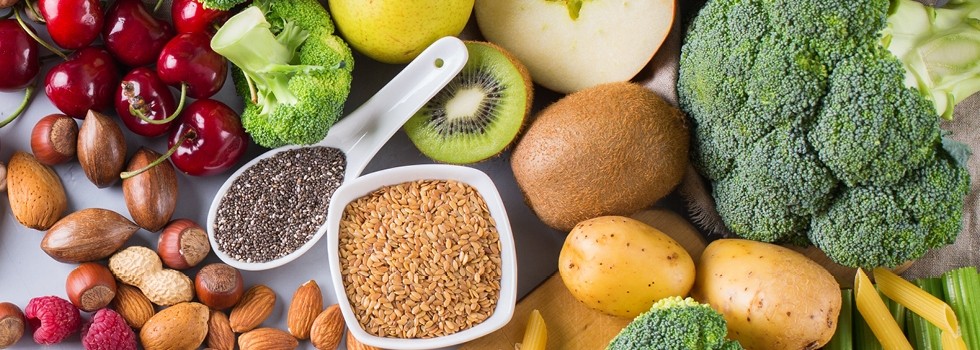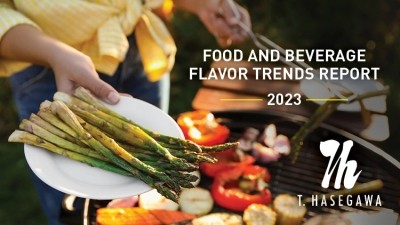Promotional Features
Putting the ‘New’ in Nutrition: How Flavor Innovation is Redefining Healthy Eating
Demand has never been greater for healthier foods and beverages, but consumers no longer have to sacrifice great taste in the pursuit of eating better, thanks to innovations in science and technology.
In the 1930s, American nutritionist Dr. Victor Lindlahr coined the popular phrase “you are what you eat,” launching a health food movement that has continued to gain momentum worldwide over the last century. But even Dr. Lindlahr couldn’t have predicted the advances that nutritional medicine and flavor science would bring to the health food category. As consumers have become better educated on the impact of nutrition – resulting in a wide range of specialty diets, plus the rise of organic and all-natural categories – the food and beverage industry has evolved to deliver on the increased demand for healthy eating. While recent events like the pandemic emphasized the importance of healthy eating to maintain physical and mental wellness, the category is now pressured by economic challenges. The role of flavor science is rapidly evolving to offer great-tasting solutions that still address complex nutritional needs.
Expanding the Definition of “Healthy”
After three years of pandemic life and growing economic uncertainty, the landscape of healthy eating is transforming. According to Mintel research, 53% of U.S. adults would like to eat healthier and plan to do so this year. But the major change recently is how “healthy eating” is defined. New FDA guidelines in 2023 will require that foods labeled “healthy” will need to contain a certain amount of a good food group such as fruits, vegetables, grains, proteins or dairy, and can’t contain too much saturated fat, sodium or added sugars. While that may help officially define the terminology, consumers are settling into a more nuanced approach to healthy eating that disregards one-size-fits-all diet standards in favor of a more balanced, personalized path.
The biggest challenge in 2023 will be economic concerns, including rising inflation and supply-chain issues. Over half of U.S. consumers have had to make compromises over the last year due to grocery prices, posing a threat to new product innovation. Brands will need to lean more heavily into providing value through health claims, to overcome consumer concerns about price increases.
Advancing Healthy Eating Through Technology
As the definition of healthy eating becomes much broader and nuanced, food and beverage brands are challenged with producing great tasting products that still deliver on consumers’ growing expectations about nutrition and wellness. The flavor industry is responding with inventive new technologies that make it possible to enjoy health-focused foods and beverages without compromising flavor. California-based T. Hasegawa USA, the U.S. subsidiary of one of the world’s top 10 flavor manufacturers, is leading the industry in developing innovative technology and processes that improve the flavor and taste experience of foods and beverages – no matter what is added or subtracted from these products to make them more appealing to health-minded consumers.
“It’s an exciting time for flavor innovation because we’re leveraging science to produce all-natural solutions that make healthy eating more accessible and even enjoyable for consumers,” explained Jim Yang, T. Hasegawa’s VP of research & development. “There is an immediate effect on the flavor of any food product when you modify the formula to reduce ingredients like sugar or fat content or add functional ingredients with a specific health claim. Technology is allowing us to modify – on a molecular level – the way people experience foods and beverages, for optimal flavor and taste.”
T. Hasegawa recently introduced several proprietary advancements aimed at going beyond flavor and improving the overall taste experience of food and beverages. One example is BOOSTRACT™, a flavor modulation technology that adds or enhances the effect of kokumi (Japanese for “rich taste”). This unique, all-natural technology improves the mouthfeel and richness of the taste experience, while also masking unwanted flavor notes and amplifying the flavor characteristics that consumers desire the most.
“Our understanding of kokumi is growing, but it’s increasingly being considered the ‘sixth’ of the basic tastes and has a major impact on the way we experience foods,” explained Yang. “Technologies like Boostract allow us to focus on important role of richness and mouthfeel – unlocking the flavor potential of many products.”
There have also been major advancements recently that directly address the evolving role of health and wellness in the dairy category, such as EmulsiTRACT™ , an all-natural, plant-based milk colloid emulsion technology. This advanced fat mimetic process provides an effective solution for brands that need to simulate the creaminess and rich mouthfeel of traditional dairy in a wide range of products. In addition to providing a creamier consistency to non-dairy beverages or low-fat dairy products, this innovative technology naturally replicates the richness that whole milk or cream provides, without the use of dairy products or costly edible oils, which have surged in price over the last couple years.
The War on Sugar
Across all categories, sugar consumption continues to be a major concern for U.S. consumers and remains at the forefront of healthy product innovation. According to Mintel, low sugar content is a top factor for 29 percent of U.S. consumers when shopping for food and drink. U.S. food and drink product launches with “no added sugar” claims have more than doubled over the last 10 years. Health organizations have specifically advocated for reducing sugar intake in an effort to reduce obesity and cardiovascular diseases. While the frontline battle in the ‘war on sugar’ was previously the sugar source, such as high fructose corn syrup, natural cane sugar varieties or even other sweeteners, consumers are now seeking all-natural or unsweetened options that rely heavily on innovative flavor development to deliver excitement and thrill our taste buds. Consumer distrust of low- or no-sugar claims remains high, with less than a quarter of U.S. consumers saying they trust “zero” sugar claims on food and drink, presenting a communications challenge for food and beverage brands. While the logical approach is to explore naturally-derived sweeteners, consumers need education and guidance to better understand the complexity and science behind natural sweeteners – a category that includes often technical, unnatural-sounding names like erythritol and allulose. According to Mintel research, consumers are less likely to avoid natural sweeteners like stevia and monk fruit, but a third of consumers aren’t seeking out natural sweeteners at all.
As concerns over sugar and all-natural sweeteners continue to pique the interest of both brands and consumers alike, the key to success will be developing new ways to deliver flavor intensity without relying on sweeteners. Through flavor modulation, BOOSTRACT and other innovations, the flavor industry is poised to help elevate foods and beverages to maintain clean-labels while minimizing all forms of sugar and sweeteners.
Adding Value by Adding Ingredients
As food and beverage brands brace for further economic challenges this year, the best strategy for successful health-focused product launches is delivering value through functional ingredients. While some consumers approach healthy eating by reducing intake of calories, fat, sodium or specific ingredients, product launches with “natural,” “minus” or “free-from” claims have all declined since 2019. Instead, many consumers are seeking products with a “plus” claim, via functional ingredients. The biggest winner in this category is antioxidants, which have a broad appeal and mainstream awareness. Research suggests that more than 40 percent of U.S. adults would like to see more antioxidants in their food and drinks but may not be aware of naturally-occurring sources of antioxidants. Exploring antioxidant superfood flavors such as berries, orange, aronia, guava, green tea and coffee can boost functionality while appealing to health-minded consumers, yet still offering a bold taste with minimal reliance on sweeteners.
Going beyond antioxidants, consumers are increasingly looking for holistic functionality in the form of adaptogens and nootropics that focus on mental and emotional health, particularly among young consumers. Adaptogens such as maca or ginseng are being leveraged for their energy-boosting properties, while rhodiola and lion’s mane offer mental clarity, and reishi or chaga can boost immune health. These ingredients are far from mainstream but growing more popular as they become the focal point of product innovation and deliver on the health aspects that are increasingly important to consumers. Product development in this category relies heavily on flavor science to mask unwanted flavor notes that result from added adaptogenic and nootropic ingredients.
Having Your Cake and Eating it, Too.
Despite the increased awareness of healthy eating in recent years, consumers still seek permissible indulgence in the form of sweet treats. As expected, consumption of desserts and confections spiked sharply during the earliest stages of the pandemic. Nearly every category of desserts and confections saw a significant bump in sales in 2020 as U.S. consumers sought comfort and stress-relief in the feel-good familiarity of sweet treats. This trend didn’t last long though, as dessert sales began declining in 2021 as the pandemic threat waned and this decline continued through 2022.
Consumers are growing more aware of how a balanced diet is a critical part of their health and well-being. In the desserts category, this often means smaller portion sizes or seeking out exciting new ingredients and flavors that deliver an indulgent experience with minimal calories and fat. A major change in recent years is the shift toward plant-based diets, which is impacting the dessert category as animal-sourced ingredients such as butter, eggs, milk and cream are replaced by plant-based alternatives. While these ingredients were initially introduced as a healthier option, the rising cost of dairy products and general economic pressure is encouraging the use of plant-based foods as a healthy, ethical and eco-friendly alternative.
The dessert category is even beginning to explore holistic wellness through functional ingredients, ranging from probiotics and vitamins to adaptogens and botanical substances that support sleep and gut health while reducing stress, improving mental clarity, immune health and more. While these functional ingredients are usually introduced to consumers in beverages, they are becoming increasingly prominent in Better-For-You desserts ranging from baked goods to pudding, candy, frozen treats and others.
Food and beverage brands who are looking to take their health and wellness products to the next level of flavor can explore the possibilities by contacting T. Hasegawa USA at www.thasegawa.com or by calling (866) 965-0502.







